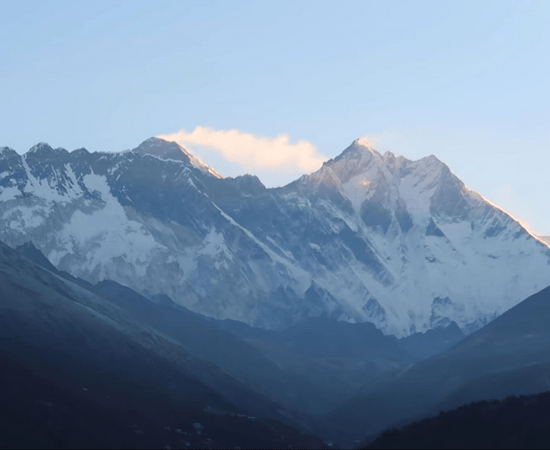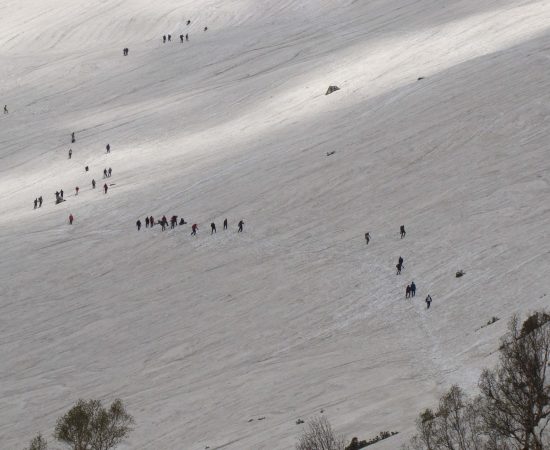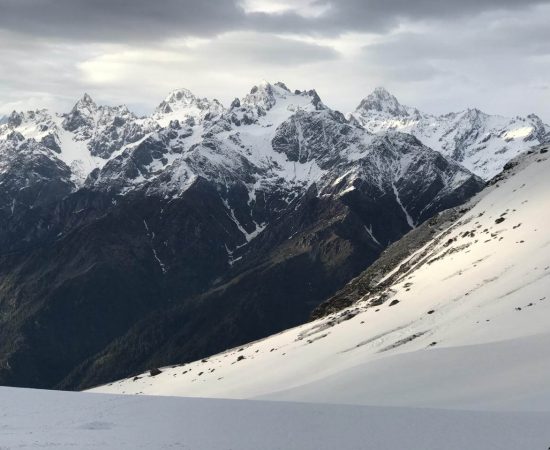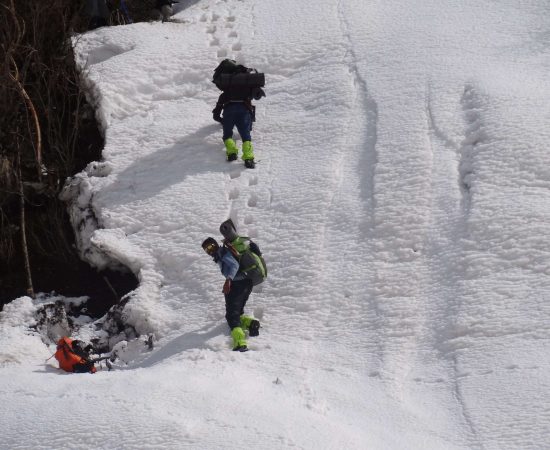Chandratal Baralacha Trek
Manali, Himachal Pradesh
Rated 4.9/5.0 on TripAdvisor. 550 Reviews


Key Highlights
- Altitude : 4890 m / 16130ft.
- Time : 7 Days - 6 Nights
- Region: Region: Manali
- Best Time: May to November
- Grade: Difficult
Overview
Chandratal Baralacha Trek
Between the Rohtang and Kunzum passes, at a height of 14,500 feet, lies the glacial lake known as Chandratal. It takes a whole day to travel from Manali to the lake. Bring your own equipment and supplies from Manali since there is no habitation along the route. Camp on the lake's shores for the first night. It is deeper and bigger (4 km in circle) than it seems. The lake's border is the Chandra River. A 18-kilometer walk is required on the first day. On the river's upstream side. past the enormous island of reverie known as Samudra Tapu, which is completely frozen throughout the winter. The night camp of Topkogongma is next to a creek. The second day starts at 7 a.m. with a crossing of the chilly Stream.
Before noon, one must cross the next, much bigger stream (topkoyongma), since after that, it gets too inundated with glacier melt. Set up camp on a hill with a river view. 15 500 feet tall. The third day's trek was a lot nicer and easier. Over pastures, beyond the Chandra River's source, the magnificent Majestic Baralacha Glacier, on your left (west). We arrived at the Baralacha pass after six hours (16500 feet). This is on the Manali-Leh highway, and from here you may catch a car back to Manali. wildlife sightings of marmots Birds, wagtails, black redstart, sand lark, snow pigeons, choughs, lammergeyer vulture, and pica.
Cost Per Person
Key Highlights
- Altitude : 4890 m / 16130ft.
- Time : 7 Days - 6 Nights
- Region: Manali
- Best Time: May to November
- Grade: Difficult
Complete
➽ Itinerary of Trek
Following a filling breakfast, we will drive to Batal (Spiti Valley) (123 Km. 6 to 8 hours ). After leaving Chota Dara, we will go along the Chandra River's right bank. The Bara Shigri glacier can be seen well on the left. The 25-kilometer-long Himalayan glacier stands above all of this. There are many notable peaks where courageous mountaineers have scaled the sky, including White Sail, Shigri Parbat, and Kullu Makalu.
Following a filling breakfast, we will drive to Batal (Sapiti Valley) (123 Km. 6 to 8 hour ). After leaving Chota Dara, we go along the Chandra River's right bank. The Bara Shigri glacier can be seen well on the left. The 25-kilometer-long Himalayan glacier stands above all of this. There are many notable peaks where courageous mountaineers have scaled the sky, including White Sail, Shigri Parbat, and Kullu Makalu.
After passing under a bridge just after Batal, we continue climbing towards Kunzum la, following a little stream that rises above the pass. The Spiti valley, which stretches 170 kilometres to the south, may be seen as you arrive at the pass. Go along the road that goes to the lake. The large meadows are accessible through an 8-kilometer route and are a popular location with several shepherd cottages. After navigating a lengthy stretch of unforgiving terrain and a small stream, the lake may be reached. The Samudra Tapu glacier, North Dakka glacier, South Dakka glacier, and Silver glacier are the most breathtaking features seen across the Chandra river. Overlooking the glaciers are the massive mountains of C.B. and Moulkila. Eight kilometres after leaving Kunzom, we arrive at Chandratal, which offers a panoramic view of the Chandra Bhaga hills all around. Camp will thereafter follow Chandratal.
It was a challenging and gruelling climb, but it was well worth it since sometimes, hikers would come across tracts of lush pastureland. It is about 14 and 16 kilometres long. Through a steep valley and boulder fields, the track starts with a sequence of ascents and descents. You will see a flat, grassy area that slopes up to a ridge covered with snow as you go on. If you're fortunate, you could hear and even see snow cocks. The route descends a slope with a steep cliff after three hours, down to the river far below on the left. Cross the stream or look for Snow Bridge close to the source if the water level is low. Alternately, camp and make the crossing as soon as possible the next morning.
Trek across a little valley flanked on both sides by snow-capped mountains. Star stroll as early as you can since this creek has to be crossed early in the day when the water flow is lower. The valley widens out into a broad plateau after you cross the river, and camp is set up in a lovely grassy area there.
Today, leave camp early to go to the seven-kilometer-long Baralacha la pass, which serves as the source of three rivers: Yunam, which flows into Zanskar, via upper Lahul, and Chandra, which travels through the south. The path offers breathtaking views of the Moulkila range's greatest peak, M-4, as well as the Keorang range of the Great Himalayas. At the pass, merge onto the main road. Our car will pick us up here and take us to Manali.
Now it's time to go home because it is the last day of the trek. Say goodbye to new memories, friends and culture. Promise to come back again.
Enquiry For Group Bookings
Guidelines
➽ Preparation for Trek
As you well know, the great Himalayan trek is one that requires careful preparation, a strategy that allows for enough flexibility to adapt to whatever challenges may arise.
Therefore, here are some things to consider before setting out on your trek:
⦿ Physically – You should start working out at least a month before signing up for a program if you want to be physically prepared for the rigours of a journey. Strengthen your legs by jogging and working out regularly to increase your stamina. To better acclimatise to the environment and increase your resilience on the walk, you should give up smoking and undertake breathing exercises twice a day. Engage in vigorous physical activity, such as playing sports, doing Yoga, or running.
⦿ Mentally –
Getting in shape physically is essential, but mental preparation is just as crucial for a successful walk. Take time to enjoy your regular activities, maintain a healthy diet and sleep schedule, and unwind before embarking on a hike. Predictions regarding the journey should not cause mental worry. Spend time with your closest pals to recharge your batteries and renew your spirit. Pre-trek preconceptions are unwarranted since the first contact with the other trekkers is certain to be a source of inspiration and energy. Conditions during the walk will contribute to the increase in mental readiness. The mental repercussions of physical disadvantages will not be ignored. So, when you hike, pay attention to different regions of your body and purposefully relax them. If you want to enjoy your hike, you should learn to loosen up a little, particularly in the hips. Think about your descent as a simple dance, and enjoy the natural rhythms that the path and your body can discover together gradually, whether you're on a flowing downhill route or a frightening slope. Try out a few new walking techniques to add some fun to your commute without worrying about getting somewhere in particular. Maintaining mental fitness mostly requires a willingness to relax and take in the journey, rather than subjecting oneself to undue stress.
⦿ Technically-
Get the right size hiking boots and go for it, from a technical standpoint. You should make use of 60 litres. To become acclimated to carrying heavy items, it is recommended to utilise a backpack on a regular basis. Get a hiking stick, a water bottle, some thermal socks, a fleece or feather coat, some long pants, a poncho, some flip-flops, and any devices you may need like a camera or a power bank (DSLR or digital camera).
Guidelines
➽ Things to Carry
- Good Trekking Boots: You need sturdy trekking boots with supportive high ankles. Don't bring your running shoes. U can carry extra floaters/flip flops also.
- Wear warm clothing, such three-layer coats, fleece upper, hollow fill or down-filled jackets. Carry full-sleeved T-shirt. Carry cotton hiking trek pants and warm pant for your lower body. Never bring shorts or jeans on a hike.
- Take top and bottom thermals with you.
- Quick dry towel with light weight and Personal toiletries. Suns cream lotion, sanitizer, tooth brush ad toothpaste, lip balm and antibacterial powder.
- Socks: Bring two pairs of regular socks and two pair of wool socks for wearing at night.
- A head torch is required.
- Sunglasses/ Goggle: UV-protected sunglasses are necessary to protect against sunlight and Snow Mountain.
- There should also be a woolen cap / balaclava, cap, neck gaiter cum face mask and warm fleece and waterproof summit gloves since it will be chilly. Keep waterproof gloves on hand since they become wet in the snow.
- Everyone taking part in the activity should have their own lunchbox, spoon, mug and water bottle/ hydration pack of 2 ltr.
- Raincoats/ponchos: Since snowfall and rain are frequent at high elevations, it is important to have one on hand so as to avoid getting wet.
- Trekking bag of 75 ltr with rain cover.
- Walking stik.
- Electronics: camera (optional) USB cable/USB solar charger, charger/earphones, Power bank fully charged.
- Personal first aid box. Emergency ration, energy bars, dry fruit, electoral/Ors
- Required Documents:
a) Registration Form
b) Medical Certificate (signed by a licensed MBBS physician)
c) NOC form (completed by the trekker)
d) 2 passport-size photos
e) ID Proof photo (not PAN)
g) Insurance upto 5 lac..
Guidelines
➽ How to Reach
How to reach Manali:
Delhi and Manali are linked nicely. You may travel from Delhi to Manali in 12 to 14 hours via overnight bus (approx 540 KMS). Online ticket reservations are available at www.redbus.in and www.hrtc.gov.in Tip: Given the distance between Delhi and Manali, the majority of Volvo private buses depart Delhi between 5 and 8 p.m. At 8.30 p.m., the final government bus departs from ISBT Kashmere Gate. Between Rs. 1,200 and Rs. 1,800 are charged by Volvo buses each sector from Delhi to Manali and vice versa. Delhi to Manali: Buses depart from Manali for Delhi between 4 and 8 p.m., same like the return trip. You should expect to arrive in Delhi any time between six and ten in the morning. Plan your subsequent trips just after midday, leaving ample time for bus delays.
How to reach Naggar:
Naggar is 18 kilometres from Manali, and there are several buses that operate every 15 minutes. Alternatively, one may get out at Patlikuhal, which is 5 kilometres from Naggar on the right bank highway. Between Kullu and Manali is Patlikuhal. To get to Naggar, you may take a cab or a local bus from Manali or Patlikuhal.
The closest train station is:
Ambala (350 miles) and Chandigarh are the closest railway stations (310 kms). Advice: From Chandigarh to Manali, regular buses and Volvos run in the evening. Volvo buses from Chandigarh to Manali and vice versa charge between Rs. 800 and Rs. 1,200 every sector.
The closest airport:
The closest airport to Manali is Bhuntar, which is 52 kilometres distant. From Bhuntar to Manali, taxi services are available and cost between Rs. 1500 and Rs. 2,500. Air travel between Bhuntar and Delhi is convenient. Airlines providing flights from Delhi and Chandigarh to Kullu include Indian Airlines, Kingfisher Airlines, MDLR Airlines, and Jagson Airlines.
➽ Trip Cost Includes
- Conveyance within the journey.
- Tents that can be shared.
- Advanced and knowledgeable himalayan adventure trips guide.
- Cooks, helpers, and other necessary personnel.
- Vegetarian meals (breakfast, lunch, and dinner) along the journey
- Every organisational prerequisite for a journey
- First aid kit with portal oxygen.
- Camping fees and forest permits.
- All permissions for hiking.
- All meals will be supplied while on the hike. Freshly cooked meals will include a mix of indian, chinese, and continental cuisines.
- Lodging at a hotel, guest house, home, or in tents.
- All of the group's trekking equipment (tents at base camp, use of base camp facilities)
- All trip workers, including porters and mules for everyday items (such as food, tents, and utensils)
➽ Trip cost Excludes
- Airfare or other forms of transportation costs.
- Meals and hotel accommodations.
- Personal costs include washing, cell charging, and lodge showers
- Entry permits or permission for the inner line for foreign participants.
- Personal apparel and hiking supplies, such as liners for sleeping bags and walking sticks, are required.
- Any expenditures associated with rescue efforts or an early expedition departure.
- Guides and sherpa crew are tipped.
- Personal porters to carry hikers' packs
- Personal liability insurance or emergency evacuation costs
- Personal purchases (such as bottles of mineral water, bottled or canned drinks, chocolate, dried fruit, presents, etc.).
- From and to the trailhead, food.
- 5% goods and service tax (gst).
Guidelines
➽ Special Casual Leaves
Government employee can avail the benefit of special casual leave when u join us for a trekking expedition. As per the rule of the pay commission, special casual leave can be availed for up to 30 days in a calendar years for trekking and mountaineering expeditions through a register organization. Himalayan adventure trips are a register adventure tour operator register with Indian mountaineering foundation and Himachal Pradesh tourism. Candidates have to apply for leave at least 30 days before the trek/expedition start.
Testimonials
➽ Provided By The Customers
Everything about our visit to Prashar lake was better than we could have imagined. From our initial contact with Himalayan Adventure Trips, we felt their genuine interest in learning about our group's goals and expectations, and our travels with them reinforced at every turn that they not only understood our requirements but also have the acute skill and expertise to achieve them. Having already had such a wonderful experience with this firm, I will be promoting a trek to Prashar lake to all my friends who share my passion for hiking and will specifically recommend that they work with this outfit. Absolutely fantastic; I have nothing but praise for it.
How useful was this post?
Click on a star to rate it!
Average rating 5 / 5. Vote count: 2
No votes so far! Be the first to rate this post.







